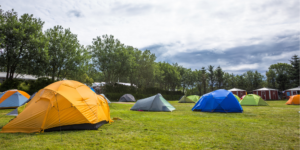
Por Ben Irwin. San José Spotlight.
San José está considerando agregar lugares seguros para dormir a su larga lista de respuestas a los residentes sin hogar, una idea que los funcionarios han rechazado antes.
En medio de que la ciudad declaró la falta de vivienda como una emergencia la semana pasada, los líderes locales quieren espacios de vida al aire libre supervisados con servicios de apoyo para los residentes sin vivienda de la ciudad. Ya existen lugares seguros para dormir en San Diego y San Antonio, Texas, y el alcalde Matt Mahan dijo que soluciones similares podrían ayudar a sacar de las calles a las personas sin hogar.
Haven For Hope, el mega refugio de 22 acres de San Antonio reconocido a nivel nacional que ofrece una variedad de soluciones para personas sin hogar a unos mil 700 residentes, ha llamado la atención de Mahan. Le dijo a San José Spotlight que lo que le interesa específicamente, es la escala y el patio de 1.5 acres que alberga a cientos de personas en catres con acceso a tres comidas al día, duchas y atención médica y de salud mental. No se permiten armas, alcohol ni drogas, pero no se requiere sobriedad en este refugio.
“Parte de lo que me atrae, es que es un paso leve e incremental hacia el objetivo final (de vivienda permanente)”, dijo Mahan a San José Spotlight. “Es seguro, comienza a conectar a las personas con los servicios y crea el primer trampolín para el siguiente paso, que podría ser algo así como una vivienda provisional”.
La idea de un campamento para personas sin hogar autorizado no es nueva. En 2015, el entonces concejal Don Rocha encabezó la iniciativa para crear lugares seguros para dormir un año después de que las autoridades despejaran “La Selva”, un enorme campamento que albergaba a 200 personas.
En 2019, la ciudad permitió que funcionara un campamento para personas sin hogar durante aproximadamente seis meses en Hope Village a lo largo de Ruff Drive, cerca del Aeropuerto Internacional San José Mineta, un área cercada con tiendas de campaña y baños. Hope Village fue desmantelada y limpiada después de que la Administración Federal de Aviación considerara que el sitio era inseguro. No se pudo conseguir una ubicación alternativa.
San José consideró autorizar campamentos nuevamente en 2021 en medio de la pandemia de COVID-19, pero los concejales archivaron la idea debido a preocupaciones sobre el uso de recursos de la ciudad para supervisar los campamentos y si serían efectivos para reducir la falta de vivienda.
Mahan no imagina un lugar local seguro para dormir tan grande como Haven for Hope; dijo que 250 camas es generalmente el rango que San José ha tenido éxito con las comunidades de viviendas provisionales.
Mahan ha dicho durante mucho tiempo que su objetivo es exigir que las personas sin hogar “vivan en el interior” una vez que la ciudad tenga suficientes camas para ofrecer. El caso Martin v. Boise, que comenzó en 2009 y se resolvió en 2019, estableció que los gobiernos no pueden criminalizar a las personas sin hogar cuando no tienen suficiente espacio de alojamiento para ofrecer, o sin proporcionar primero algún tipo de refugio temporal.
La abogada de la ciudad, Nora Frimann, dijo que siempre que San José esté “mejorando” un sitio consistente con el código gubernamental (declarar una crisis de refugio afloja estos requisitos) la ciudad puede usar ese sitio para ofrecer a alguien refugio de conformidad con la ley. Pero Mahan ha dicho que no es por eso que le interesan los lugares seguros para dormir: lo que más le interesa es una vida digna y segura.
El defensor de las personas sin hogar, Richard Scott, le dijo a San José Spotlight que 20 personas vivían en Hope Village en grandes tiendas de campaña, y que aún podría replicarse hoy y atender potencialmente a más residentes sin vivienda dependiendo de la cantidad de terreno disponible.
“Era un campamento ideal autorizado”, dijo Scott a San José Spotlight. “Es lo que necesitamos tener ahora… El condado y la ciudad tienen terrenos baldíos por todas partes. El problema es tratar de lograr que los utilicen para todo esto”.
La concejal Pam Foley dijo a San José Spotlight que no hay una gran cantidad de terreno disponible para su uso, lo que es un obstáculo para la construcción de viviendas. Foley, junto con el resto de la junta de VTA, votó la semana pasada para arrendar 7.2 acres del sitio Cerone de la agencia de tránsito a San José durante cinco años para construir 200 viviendas temporales para residentes sin hogar. En el Distrito 9, está trabajando en un proyecto de vivienda con Valley Water cerca de Coyote Creek para el que faltan al menos seis meses.
Foley dijo que le gustaría que se realizaran más investigaciones sobre edificios comerciales vacíos cerrados por COVID-19, como gimnasios y centros comerciales, como una solución de refugio. Cuando se trata de aprobar lugares seguros para que duerman los residentes sin hogar, dijo que los tiempos cambian.
“La preocupación por los cambios comunitarios y la necesidad de abordar a las personas sin vivienda se está convirtiendo cada vez más en un tema clave dentro de la ciudad, particularmente con este alcalde”, dijo a San José Spotlight.
Te puede interesar: Guatemala; “pisoteo a la ciudadanía” desata paro nacional: Mynor Alonso

